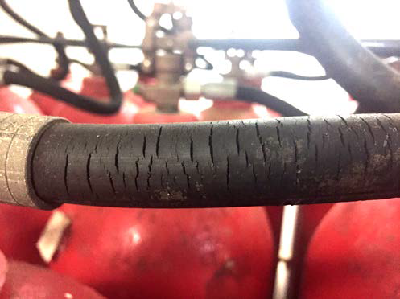Coast Guard Warns on Fixed CO2 Fire Extinguishers
The U.S. Coast Guard has issued Safety Alert 13-17 concerning fixed CO2 fire extinguishing systems: “When your hoses aren't right you might lose the firefight.”
Recently, Coast Guard marine inspectors discovered critical deficiencies on board a container ship with its fixed CO2 fire extinguishing system. The conditions associated with the CO2 system may have prevented the system from operating correctly or, if not discovered, the system may not have operated at all in an emergency situation.
During the inspection, it was noted that some of the hoses which connected the large CO2 cylinders to the manifolds were wrapped around the bottle valve handles. The bottles could have been in place for a long period of time, in their original positions without regard to the stresses placed on the connecting hoses. These bottles should have been clamped tightly in place by the use of wooden brackets. Wooden spacers in between the rows of bottles can also be used to ensure proper securing of all the bottles.
 Inspectors also found significant cracking of the CO2 discharge hoses which were under tension. This condition is known as ozone cracking and occurs when very small amounts of ozone in the atmosphere interact with the polymers that compose rubber products and certain other elastomers when those products are under tension.
Inspectors also found significant cracking of the CO2 discharge hoses which were under tension. This condition is known as ozone cracking and occurs when very small amounts of ozone in the atmosphere interact with the polymers that compose rubber products and certain other elastomers when those products are under tension.
As a result of the inspection the vessel was detained until these and other identified deficiencies identified were corrected. During a reinspection of the vessel to clear the deficiencies, it was discovered that the servicing organization that replaced the hoses had installed several new hoses in a similar orientation that maintained excessive stress on the hoses. That issue was subsequently rectified by rotating the bottles.
In June of 2009 the IMO released MSC.1/Cir.1318, titled Guidelines for the Maintenance and Inspections of Fixed Carbon Dioxide Fire-Extinguishing Systems. It provides the minimum recommended level of maintenance and inspections for fixed carbon dioxide fire-extinguishing systems on all ships in order to demonstrate that the system is kept in good working order as specified in SOLAS regulation II-2/14.2.1.2. In addition to other important information, it provides useful maintenance and inspection guidance.
One related monthly inspection item suggests checking that all "high pressure cylinders are in place and properly secured."
The U.S. Coast Guard strongly recommends that vessel owners and operators obtain MSC.1/Cir.1318 for distribution to their fleets. In addition, each vessel's Safety Management System should incorporate the Circular's pertinent data. The Coast Guard also urges owners and operators to ensure the following steps are taken for each fixed CO2 system:
* Bottle installation must be accomplished carefully considering hose and actuator positioning in addition to ensuring stress is minimized for each hose. Securing devices must be inspected for effectiveness.
* Vessel crewmembers should check for bottle rotation, loose bottles, and excessive stress on discharge hoses during periodic inspections of fixed CO2 systems. All appropriate safety precautions should be completed prior to taking any actions to re-secure or reposition CO2 cylinders.
